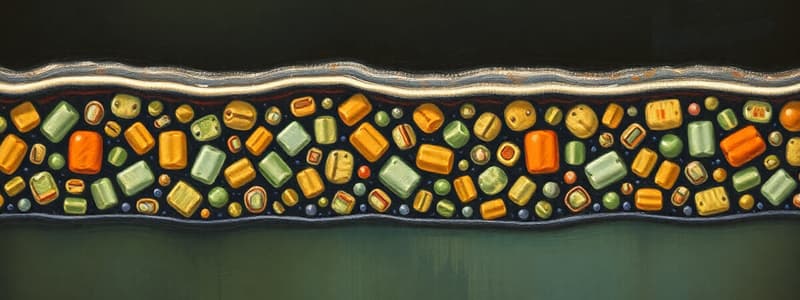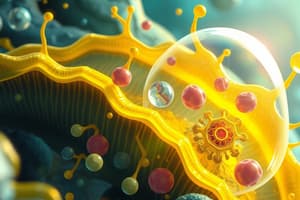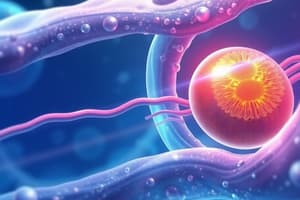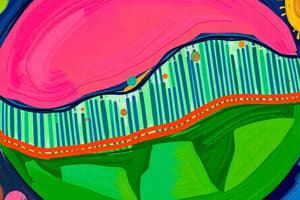Podcast
Questions and Answers
What characterizes simple diffusion across the cell membrane?
What characterizes simple diffusion across the cell membrane?
- It is dependent on a concentration gradient. (correct)
- It requires a specific carrier protein.
- It is exclusive to water-soluble molecules.
- It requires energy input from ATP.
Which statement best describes facilitated diffusion?
Which statement best describes facilitated diffusion?
- It involves carrier proteins assisting polar molecules. (correct)
- It only occurs for lipid-soluble molecules.
- It requires energy from ATP.
- It can transport substances against their concentration gradient.
Which type of molecules can readily diffuse through the cell membrane?
Which type of molecules can readily diffuse through the cell membrane?
- Ions, without any assistance.
- Lipid-soluble molecules. (correct)
- Large polar molecules.
- Organic anions, such as proteins.
What is the main factor determining the permeability of a molecule across the membrane?
What is the main factor determining the permeability of a molecule across the membrane?
What role does the Na+/K+ pump play in maintaining membrane potential?
What role does the Na+/K+ pump play in maintaining membrane potential?
During facilitated diffusion, what provides the energy for molecular movement?
During facilitated diffusion, what provides the energy for molecular movement?
Which of the following best describes the process of endocytosis?
Which of the following best describes the process of endocytosis?
What is the predominant characteristic of voltage-gated channels?
What is the predominant characteristic of voltage-gated channels?
What type of transport moves molecules down their concentration gradient without requiring energy?
What type of transport moves molecules down their concentration gradient without requiring energy?
What is required for Active Transport to occur?
What is required for Active Transport to occur?
Which type of transport utilizes the kinetic energy of one substance to drive the transport of another substance against its gradient?
Which type of transport utilizes the kinetic energy of one substance to drive the transport of another substance against its gradient?
What characteristic defines gated channels in membranes?
What characteristic defines gated channels in membranes?
What mediates the functioning of ligand-gated channels in cell membranes?
What mediates the functioning of ligand-gated channels in cell membranes?
What property of protein channels ensures selectivity in the diffusion of molecules?
What property of protein channels ensures selectivity in the diffusion of molecules?
Which of the following describes a characteristic of primary active transport?
Which of the following describes a characteristic of primary active transport?
Which type of transport protein undergoes a conformational change to transport molecules across the membrane?
Which type of transport protein undergoes a conformational change to transport molecules across the membrane?
Which type of membrane transport does NOT require direct ATP consumption?
Which type of membrane transport does NOT require direct ATP consumption?
What identifies the role of voltage-gated channels in the cell membrane?
What identifies the role of voltage-gated channels in the cell membrane?
What happens when the outward diffusion of K+ ions is repelled by the electromagnetic force?
What happens when the outward diffusion of K+ ions is repelled by the electromagnetic force?
How is the membrane potential at equilibrium primarily determined?
How is the membrane potential at equilibrium primarily determined?
Which equation describes the balance between chemical diffusion and electrical repulsion in ions?
Which equation describes the balance between chemical diffusion and electrical repulsion in ions?
What is the equilibrium potential for K+ ions calculated using the Nernst Equation?
What is the equilibrium potential for K+ ions calculated using the Nernst Equation?
What is the typical resting membrane potential in neurons, despite the K+ equilibrium potential being -90 mV?
What is the typical resting membrane potential in neurons, despite the K+ equilibrium potential being -90 mV?
What initiates the creation of a diffusion pore in voltage-gated channels?
What initiates the creation of a diffusion pore in voltage-gated channels?
What role does the S4 segment play in the function of voltage-gated channels?
What role does the S4 segment play in the function of voltage-gated channels?
What occurs when the membrane is depolarized to around -50 mV?
What occurs when the membrane is depolarized to around -50 mV?
What is the primary function of endocytosis in the context of cellular processes?
What is the primary function of endocytosis in the context of cellular processes?
Which statement best describes exocytosis?
Which statement best describes exocytosis?
What characterizes the 'Kiss and Run' mechanism of exocytosis?
What characterizes the 'Kiss and Run' mechanism of exocytosis?
Why is full exocytosis essential for cells?
Why is full exocytosis essential for cells?
What is the role of the enzyme ion pump in generating membrane potential?
What is the role of the enzyme ion pump in generating membrane potential?
What condition is necessary for a membrane to create a membrane potential?
What condition is necessary for a membrane to create a membrane potential?
In which scenario would you expect the 'Kiss and Run' mechanism to be favored?
In which scenario would you expect the 'Kiss and Run' mechanism to be favored?
What is a consequence of full exocytosis in a cell?
What is a consequence of full exocytosis in a cell?
Which process must occur alongside exocytosis to maintain membrane equilibrium?
Which process must occur alongside exocytosis to maintain membrane equilibrium?
What happens to the contents of a vesicle during the 'Kiss and Run' mechanism?
What happens to the contents of a vesicle during the 'Kiss and Run' mechanism?
Flashcards are hidden until you start studying
Study Notes
Cell Membrane Overview
- Cell membrane is a dynamic structure, not simply a passive barrier.
- Composed of a phospholipid bilayer that selectively allows permeability.
- Lipid-soluble substances (gases like O2 and CO2) can diffuse easily; water-soluble substances require assistance.
- Impermeable to organic anions, such as proteins; permeability varies with molecular size, lipid solubility, and charge.
Membrane Transport Mechanisms
- Simple Diffusion: Small lipid-soluble molecules diffuse through the membrane down their concentration gradients without ATP.
- Facilitated Diffusion: Carrier proteins assist in transporting polar molecules (like sugars and amino acids) down their concentration gradient without ATP.
- Active Transport: Moves substances against their concentration gradient using energy from ATP hydrolysis; includes mechanisms like the Na+/K+ pump.
- Secondary Active Transport: Uses the kinetic energy of one substance moving down its gradient to transport another substance up its gradient without ATP.
Membrane Channels
- Membrane channels are composed of 4-5 protein subunits creating a central pore for selective ion diffusion.
- Channel selectivity is determined by size and charge; includes:
- Ligand-Gated Channels: Open in response to the binding of a chemical signal.
- Voltage-Gated Channels: Open or close in response to changes in membrane potential.
Endocytosis and Exocytosis
- Endocytosis: Process of inward membrane pinching to form vesicles, often receptor-mediated.
- Exocytosis: Involves vesicle fusion with the membrane to transport substances outside the cell.
- Kiss and Run: Vesicles can attach and detach multiple times, releasing partial contents.
- Full Exocytosis: Complete fusion releasing all contents, essential for high signaling levels and membrane protein delivery.
Membrane Potential (MP)
- All cells generate a Membrane Potential (MP) through a concentration gradient and semi-permeable membrane.
- MP is established when ion species diffuse across the membrane creating an electrical gradient.
- Ion pumps (like the Na+/K+ pump) are critical in maintaining concentration gradients for MP.
Resting Membrane Potential (RMP)
- Neurons have an RMP around -70 to -80 mV, influenced by the diffusion of K+ ions.
- The equilibrium potential for K+ can be calculated as EK+ = (RT/F) ln([K+]o / [K+]i), resulting in -90 mV if only K+ ions are considered.
Nernst Equation
- Describes the balance between chemical diffusion work and the electrical work of repulsion.
- Used to calculate the equilibrium potential across the membrane for a specific ion species.
Studying That Suits You
Use AI to generate personalized quizzes and flashcards to suit your learning preferences.





